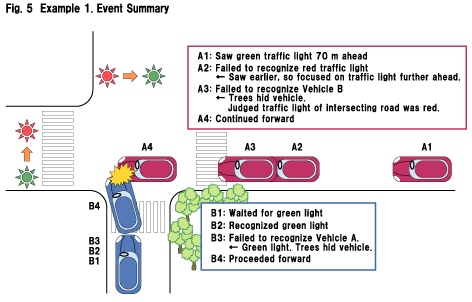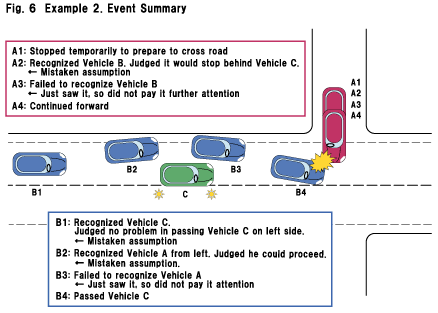 |
||||
|
||||||||

|
| To facilitate understanding of the results of the analysis, we will first introduce several examples of accidents. The underlined portions indicate the error or a factor that caused error. By "error", we mean not only cases of negligence, but also the "failure to act" to more actively avoiding accidents. Furthermore, the numbers following "A" and "B" correspond to the points in time in which the event occurs. [Example 1] Crossing Collision Occurring As Result Of Ignoring Traffic Light At Intersection With Traffic Light Situation A1: Driver A confirmed that the oncoming traffic light approximately 70 m ahead was green. A2: Driver A failed to recognize that the oncoming traffic light turned red. This was because Driver A had just confirmed that the light was green, so had his attention occupied with the other traffic light further ahead. A3. Driver A failed to recognize Vehicle B. This was because Driver A assumed that the traffic light at the intersecting road was still red and the trees hid the vehicle. A4: Driver A continued onward. B1: Driver B halted because the oncoming traffic light was red. B2: Driver B recognized that the traffic light turned green. B3: Driver B failed to recognize Vehicle A. This was because since the oncoming light was green, he was not concerned about other vehicles and also the trees hid the vehicle. B4: Driver B continued forward without hesitation. |

|
|
[Example 2] Crossing Collision Occurring At Road Crossing Main Artery Without Traffic Light Situation A1: Driver A halted at the stop line to prepare to cross the main artery. A2: Driver A recognized Vehicle B to his right. However, Driver A judged incorrectly that Vehicle B would stop behind Vehicle C waiting to make a right turn. This was because of a mistaken assumption. A3: Driver A failed to recognize Vehicle B. This was because Driver A had just seen it, so did not pay it any further attention. A4: Driver A continued forward. B1: Driver B recognized Vehicle C waiting to turn right. Driver B judged incorrectly that there would be no problem in passing on the left side of Vehicle C. This was because of a mistaken assumption. B2: Driver B recognized that Vehicle A was waiting to enter the intersection from the left side road. Driver B judged incorrectly that Vehicle A would wait for Vehicle B to pass. This was because Driver B thought that since he could see Driver A, Driver B could also see him. B3: Driver B failed to recognize Vehicle A. This was because Driver B had just seen it, so did not pay it any further attention. B4: Driver B passed Vehicle C. |

|
| UP |
Institute for Traffic Accident Research and Data Analysis (ITARDA) |